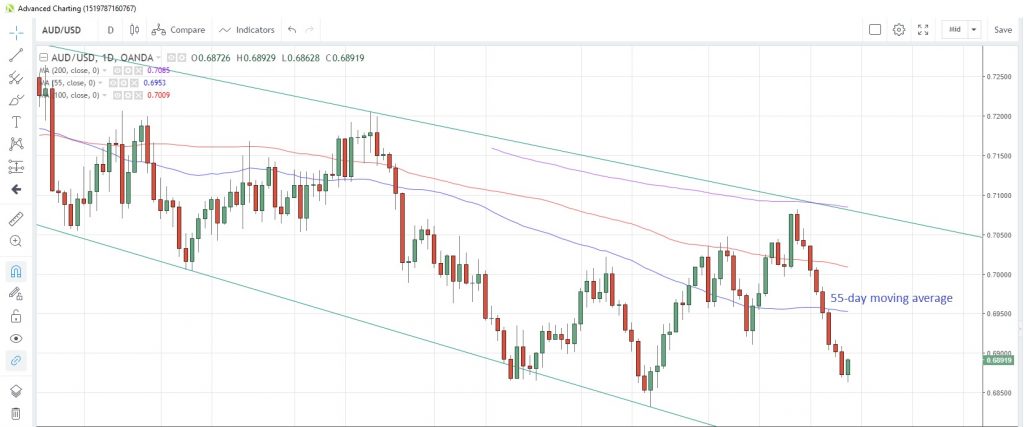Manufacturing PMI still below 50
The Australian dollar rebounded from six-week lows versus the US dollar this morning after China’s manufacturing PMI came in higher than expected. The manufacturing PMI rose to 49.7 in July, an improvement from June’s 49.4 reading and better than the 49.6 forecast. It still remained below the key 50 expansion/contraction threshold for a third straight month. The non-manufacturing PMI dipped to 53.7 from 54.2, and was contrary to expectations of an improvement to 54.5.
AUD/USD bounced from an intraday low of 0.6862 after the data, the lowest level since June 19, and could be facing its first up-day in nine sessions. The FX pair is currently trading at 0.6889 with the 55-day moving average at 0.6953.
AUD/USD Daily Chart
Australian CPI firmer than expected
Consumer prices in Australia rose 1.6% y/y in the second quarter, as measured by the RBA’s trimmed mean reading, the same pace as in Q1 but a faster rate than the 1.5% economists had expected. On the headline number, the rate of increase jumped to +1.6% y/y from 1.3% in Q1. The main culprit for the higher reading was automotive fuel, which rose 10.2% q/q. Note the RBA’s target range for inflation is 2-3%.
It’s Powell time
The main highlight for the data calendar today will be the Fed’s FOMC meeting. With a 25bps rate cut almost baked in, the market’s attention will be on the accompanying statement and on Powell’s press conference later. Any decisive hints that this will be the first of a cycle of cuts, which may or may not be “data dependent”, could be a positive for risk appetite and equity markets but a potential heavy weight for the US dollar to bear.
Euro-zone GDP on tap
Aside from the focus on the Fed later, we still have some key European data to monitor. German retail sales are seen rebounding in June, with a +0.5% increase expected, which would almost negate May’s 0.6% decline and would be the strongest growth in four months. We also get a first glimpse at the Euro-zone’s second quarter growth numbers, with estimates suggesting a slowdown to +1.0% y/y and +0.2% q/q from 1.2% and 0.4% respectively. That would tie in with the weaker numbers we have already seen from the US and China for that quarter.
You can see the full MarketPulse data calendar at https://www.marketpulse.com/economic-events/
Content is for general information purposes only. It is not investment advice or a solution to buy or sell securities. Opinions are the authors; not necessarily that of OANDA Business Information & Services, Inc. or any of its affiliates, subsidiaries, officers or directors. If you would like to reproduce or redistribute any of the content found on MarketPulse, an award winning forex, commodities and global indices analysis and news site service produced by OANDA Business Information & Services, Inc., please access the RSS feed or contact us at info@marketpulse.com. Visit https://www.marketpulse.com/ to find out more about the beat of the global markets. © 2023 OANDA Business Information & Services Inc.



